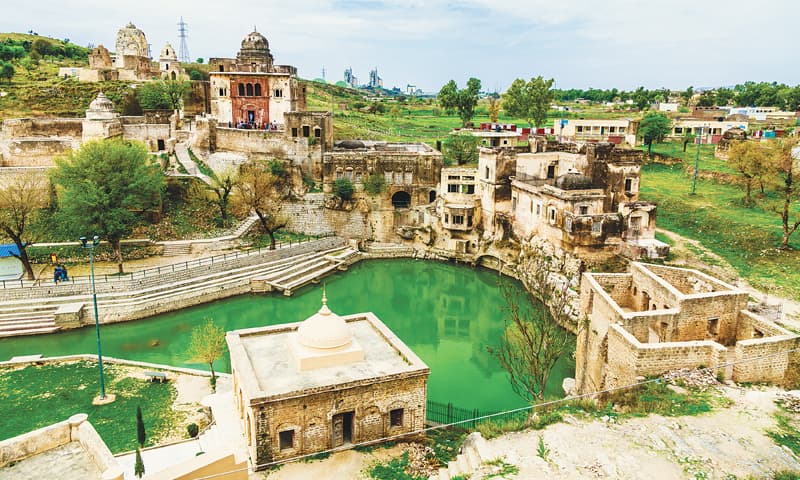The Ketas Raj temples are a valuable piece of ancient architecture and one of the oldest Hindu religious sites in Punjab, Pakistan. This splendid complex of temples dedicated to Ram, Hanuman, and Shiva, is laid around a natural pond. The complex also houses the Gurdwara of Guru Nanak, who was believed to say here during his journey around the world; and remains of the Haveli of Hari Singh Nalwa, the most famous general in Ranjit Singh’s army.
History of Ketas Raj
The main Ketas temple is believed to have existed since the days of Mahabharata, about 300 BC. Legend has it that at the death of Hindu god Shiva’s wife Satti, he wept so much that his tears created two holy ponds and Ketas pond is one of the two while the other is at Ajmer in India. Ketas is a Sanskrit word literally means “raining eyes”.
Another myth says that the five Pandava brothers stayed here for four out of the 14 years that they spent in exile. The lake in the complex is believed to have magical powers and is supposed to be where Yudhisthira defeated the Yaksha with his wisdom to bring his brothers back to life. Yet another version of the Siva legend involves the death of Shiva’s horse Katas instead of that of Satti his partner.
The Temples
The Katas site houses the Satgraha, which comprises of a group of seven ancient temples, remains of a Buddhist stupa, a few Medieval Temples, Havelis, and some recently constructed temples scattered around a pond considered holy by Hindus. The pool was surrounded by a fort, temples, bathhouses, and rest houses.
Some of the construction around the pool is clustered while there are some units spreading sparsely around the main construction site. The oldest building in Ketas is a Buddhist Stupa with remains still visible on an elevated portion of Ketas. Only the base of this stupa is intact and believed to be more than 2000 years old.
Hieun Tsang, the famous Chinese traveler visited this place in search of Buddhist text and relics in the early 7th century AD. That was the time when Buddhism took a downward spiral and largely replaced by Hinduism. Hieun’s account of travel describes the fact in the account of his travel that an ancient fort surrounds the complex of the buildings at Ketas.
The fortification wall is still intact at many places and major portions of the fort have been preserved. Sikh Raja Hari Singh Nalwa constructed a palace by the pond. Though this palace is now in ruins yet in some of the preserved rooms there are colorful pictures of Hindu gods and goddesses.
There are three temples at the highest point. Kala Mandar is the oldest one built about fifteen hundred years ago. The central temple is the largest construction with three stories having a dark narrow staircase leading to the rooftop which gives a broader view of the Ketas complex and the salt range as a whole. These Hindu Temples of Ketas were built during the Hindu Shahi Period. They are similar in architecture to the temples of Malot and Shiv Danga.
The Ketas temple has been the site of holy pilgrimage for people of various faiths. Thousands of Hindus used to flock every April to bathe at Ketas pool. The pilgrims bathe in the sacred pool and seek forgiveness as Hindu belief holds that bathing in the pond (especially on certain occasions) leads to the forgiveness of sins and helps attain salvation.
Most of the temples were built during the reign of Hindu kings around 900 years ago or more, although the earliest of the Ketas Raj temples dates back to the latter half of the 6th century AD.
Location and access
The temples are situated in Ketas village off Choa Sadan Shah, past main bazaar, in Chakwal district of Punjab, Pakistan. Ketas is 160 km from Islamabad easily accessible by taking the road to Choa Sadan Shah from Kalar Kahar interchange at Islamabad- Lahore motorway (M2).




Comment (0)